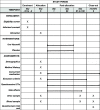Immunomodulation for primary prevention of urinary tract infections in patients with spinal cord injury during primary rehabilitation: protocol for a randomized placebo-controlled pilot trial (UROVAXOM-pilot)
- PMID: 34607600
- PMCID: PMC8489057
- DOI: 10.1186/s13063-021-05630-w
Immunomodulation for primary prevention of urinary tract infections in patients with spinal cord injury during primary rehabilitation: protocol for a randomized placebo-controlled pilot trial (UROVAXOM-pilot)
Abstract
Background: Urinary tract infections (UTIs) are common in individuals with neurogenic lower urinary tract dysfunction (NLUTD) following spinal cord injury (SCI). They are not only a great burden for affected individuals, but also cause considerable health costs. Furthermore, recurrent antibiotic treatments of UTIs contribute to the growing problem of bacterial resistance to antimicrobial compounds. Even though there is a multitude of different measures to prevent UTIs in individuals with NLUTD, no clear evidence exists for any of these. Oral immunomodulation with UTI-relevant Escherichia coli lysate may be a promising preventative measure with a good safety profile in individuals with NLUTD. However, currently available data are sparse.
Methods: This is a randomized, quasi-blinded, placebo-controlled, mono-centric pilot trial investigating the feasibility of a main trial regarding the effects of a lyophilized lysate of E. coli strains for oral application (Uro-Vaxom®, OM Pharma SA, Meyrin, Switzerland). There will be two parallel groups of 12 participants each. Individuals with acute SCI (duration SCI ≤ 56 days) from 18 to 70 years of age admitted for primary rehabilitation will be eligible. Blood and urine samples will be taken prior to intervention start, at the end of the intervention, and 3 months after intervention termination. The trial intervention will last 90 days. The participants will not be informed regarding the treatment allocation (quasi-blinded). The nursing staff will prepare the daily dose of the allocated treatment from the original packaging. The trial personnel and the biostatistician will be blinded. Feasibility (e.g., recruitment rate, patient attrition), clinical (e.g., number of symptomatic UTIs), and laboratory parameters (e.g., urinary culture, urinary proteo- and microbiome, blood cell counts) as well as adverse events will be collected.
Discussion: Effective and efficient measures for the prevention of UTIs in individuals with NLUTD are urgently needed. If the conclusion of this pilot is positive regarding feasibility, the effects of oral immunomodulation with a E. coli lysate will be investigated in a larger, sufficiently powered, multi-center trial.
Trial registration: ClinicalTrials.gov NCT04049994 . Registered on 8 August 2019.
Keywords: Escherichia coli; Feasibility trial; Immunomodulation; Immunostimulation; Immunotherapy; Neurogenic lower urinary tract dysfunction; Spinal cord injury; SwiSCI; SwiSCI biobank; Urinary tract infection; Uro-Vaxom®.
© 2021. The Author(s).
Conflict of interest statement
The authors declare that they have no competing interests.
Figures
Similar articles
-
Effects of Uro-Vaxom vs. placebo on the urinary tract microbiome in individuals with spinal cord injury in a randomized controlled pilot trial (Uro-Vaxom pilot).Sci Rep. 2025 Apr 14;15(1):12825. doi: 10.1038/s41598-025-96939-y. Sci Rep. 2025. PMID: 40229352 Free PMC article. Clinical Trial.
-
Uro-Vaxom® versus placebo for the prevention of recurrent symptomatic urinary tract infections in participants with chronic neurogenic bladder dysfunction: a randomised controlled feasibility study.Trials. 2019 Apr 16;20(1):223. doi: 10.1186/s13063-019-3275-x. Trials. 2019. PMID: 30992071 Free PMC article. Clinical Trial.
-
Effects of oral immunomodulation therapy on urinary tract infections in individuals with chronic spinal cord injury-A retrospective cohort study.Neurourol Urodyn. 2019 Jan;38(1):346-352. doi: 10.1002/nau.23859. Epub 2018 Oct 23. Neurourol Urodyn. 2019. PMID: 30350886
-
Vaccines for the prevention of recurrent urinary tract infections: a systematic review.BJU Int. 2019 May;123(5):753-768. doi: 10.1111/bju.14606. Epub 2018 Dec 19. BJU Int. 2019. PMID: 30378242
-
The prevention and management of urinary tract infections among people with spinal cord injuries. National Institute on Disability and Rehabilitation Research Consensus Statement. January 27-29, 1992.J Am Paraplegia Soc. 1992 Jul;15(3):194-204. doi: 10.1080/01952307.1992.11735873. J Am Paraplegia Soc. 1992. PMID: 1500945 Review.
Cited by
-
Vaccines against extraintestinal pathogenic Escherichia coli (ExPEC): progress and challenges.Gut Microbes. 2024 Jan-Dec;16(1):2359691. doi: 10.1080/19490976.2024.2359691. Epub 2024 Jun 2. Gut Microbes. 2024. PMID: 38825856 Free PMC article. Review.
-
The Swiss Spinal Cord Injury Cohort Study (SwiSCI) biobank: from concept to reality.Spinal Cord. 2024 Mar;62(3):117-124. doi: 10.1038/s41393-024-00958-x. Epub 2024 Jan 29. Spinal Cord. 2024. PMID: 38287141 Free PMC article.
-
Effects of Uro-Vaxom vs. placebo on the urinary tract microbiome in individuals with spinal cord injury in a randomized controlled pilot trial (Uro-Vaxom pilot).Sci Rep. 2025 Apr 14;15(1):12825. doi: 10.1038/s41598-025-96939-y. Sci Rep. 2025. PMID: 40229352 Free PMC article. Clinical Trial.


